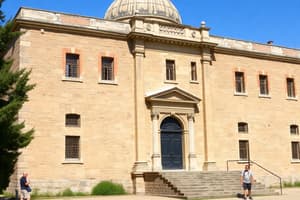Podcast
Questions and Answers
What is the primary focus of military history?
What is the primary focus of military history?
- Economic systems and trade
- Warfare and its impact on societies (correct)
- Cultural beliefs and customs
- Political institutions and leaders
Secondary sources include original documents like letters and diaries.
Secondary sources include original documents like letters and diaries.
False (B)
What methodology involves evaluating the reliability of historical sources?
What methodology involves evaluating the reliability of historical sources?
Source criticism
Historians often divide the past into distinct periods, such as __________, medieval times, and the Renaissance.
Historians often divide the past into distinct periods, such as __________, medieval times, and the Renaissance.
Match the branches of historical study with their focuses:
Match the branches of historical study with their focuses:
Flashcards
What is history?
What is history?
The study of past events, especially those involving human affairs.
What are primary sources?
What are primary sources?
Original documents or objects from the past, like letters, diaries, photographs, and artifacts.
What are secondary sources?
What are secondary sources?
Analyses and interpretations of primary sources written by historians.
What is military history?
What is military history?
Signup and view all the flashcards
What is cultural history?
What is cultural history?
Signup and view all the flashcards
Study Notes
Introduction to History
- History is the study of past events, specifically human affairs.
- It covers a wide range of topics, from the rise and fall of civilizations to individual lives.
- Historians use primary and secondary sources to analyze and reconstruct the past.
- History is not just a list of facts, but also an interpretation of the past.
Types of Historical Sources
- Primary sources are original documents or objects from the past; examples include letters, diaries, photographs, and artifacts.
- Secondary sources are analyses and interpretations done by later historians of primary sources.
- Examples of primary sources include eyewitness accounts, official documents, letters, and artifacts.
- Examples of secondary sources include textbooks, academic articles, biographies, and documentaries.
- Both primary and secondary sources are used to understand the past fully.
Historical Methodology
- Historians use various methods, including:
- Source criticism: evaluating the reliability and trustworthiness of sources.
- Contextualization: placing events and individuals within their broader historical context.
- Interpretation: formulating arguments and theories about the past.
- Synthesis: combining different viewpoints and sources to create a cohesive narrative.
- Historical analysis needs critical thinking, objectivity, and rigorous research.
- Historians aim for a balanced and nuanced understanding of the past, acknowledging diverse perspectives.
Branches of Historical Study
- Branches study specific aspects of the past, such as:
- Military history: focuses on warfare, strategies, and the impact of conflict on societies.
- Cultural history: examines values, beliefs, customs, art forms, and beliefs of various cultures and societies.
- Social history: researches the lives, experiences, and social structures of different groups.
- Political history: analyzes political systems, institutions, and leaders.
- Economic history: studies the evolution of economies, trade, commerce, and financial markets.
- Each branch applies its own particular approaches and focus.
Historical Periods
- Historians divide the past into different periods, including ancient times, the Middle Ages, the Renaissance, the modern period, and contemporary history.
- These divisions are often based on major political, social, and economic changes.
- Defining periods, and events within them, is a constantly developing field, with continuous scholarly debate.
Importance of History
- Understanding the past offers lessons to current and future generations.
- It helps us understand social evolution, the impact of major events, and the significance of different cultures.
- It promotes critical thinking and appreciation for diverse viewpoints.
- Studying history helps connect present-day issues to similar past challenges.
- History can contribute to solutions for future problems.
Challenges in Studying History
- Historians must address the limitations of primary sources, which can be incomplete or biased.
- Accurately reconstructing the past from fragmented evidence is a challenge.
- Careful analysis is required for evaluating bias, multiple interpretations, and differing perspectives found in historical records.
- Access to historical records varies greatly depending on location and time period.
- Debates on historical interpretations demonstrate the complexities and contested nature of the historical record itself.
Studying That Suits You
Use AI to generate personalized quizzes and flashcards to suit your learning preferences.




